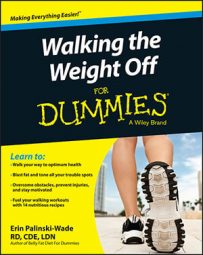If you plan to increase the amount of walking you do on a regular basis to lose weight, it’s important that you walk correctly. You know that song “the knee bone’s connected to the thigh bone, the thigh bone’s connected to the hip bone . . .”? It’s true; your bones are all connected as well as tendons, ligaments, and even your muscles.
If you throw a bone, joint, or muscle out of whack, it causes a chain reaction to the bones and joints in the rest of your body. A poor walking technique may not only lead to an increased risk of bunions on your feet but can also increase the risk of knee pain, hip pain, back pain, and so on.
If you don’t walk correctly, these aches and pains will start to present themselves, which can make continuing with your walking routine a challenge.
Take a look at how to position yourself for the healthiest walk possible:
Start by standing with your feet exactly hipbone width apart, not wider or closer.
This stance should allow your legs to be stacked straight up and down from your feet to your hips. Your toes should point forward (every toe from the big toe to the pinky toe should be facing forward — not turned outward or inward).
Picture having headlights on your hipbones, kneecaps, and big toes. Make sure all of your headlights are facing straight ahead. This position allows for the least amount of wear and tear on your ankles, knees, hips, and feet.
Now take a step forward, making sure that your foot lands with
your heel first.To do this, you must flex your foot at the ankle. If you are unable to do this, examine your footwear first. Overly stiff shoes can impede this motion, which can increase injury risk. Make sure you choose supportive shoes that also allow flexibility in your feet and ankles.
After your heel hits the ground, roll onto the ball of your foot.
The ball of your foot is essentially the midsection of your foot — the part in front of the arch but behind the toes. As the ball of your foot hits the floor, your toes should be flexed. As you roll onto the ball of your foot, pay attention to how you do it.
If you roll to one side or the other, practice walking slowly and making sure the entire ball of your foot presses against the floor as you step. If you are able to do this barefooted, but not when wearing shoes, it’s possible your shoes are too stiff.
Use your toes — all of them!
As you roll through the ball of your foot with your step, you want to roll forward onto your toes. Your pinky toe should be the first to hit the floor while your big toe should be the last. All of your toes should come into contact with the ground, in succession.
As you continue to walk, the toes should leave the ground in the same order they came in contact with it — pinky toe first, big toe last. Skipping a toe can impair your balance as well as place unneeded stress on the bones and joints in your feet.
How did you do? Does it feel odd to walk this way? If so, just take time practicing this technique over and over.
Walk slowly and really pay attention to how you are walking. It may seem silly, but improving your gait pays off in the long run.

